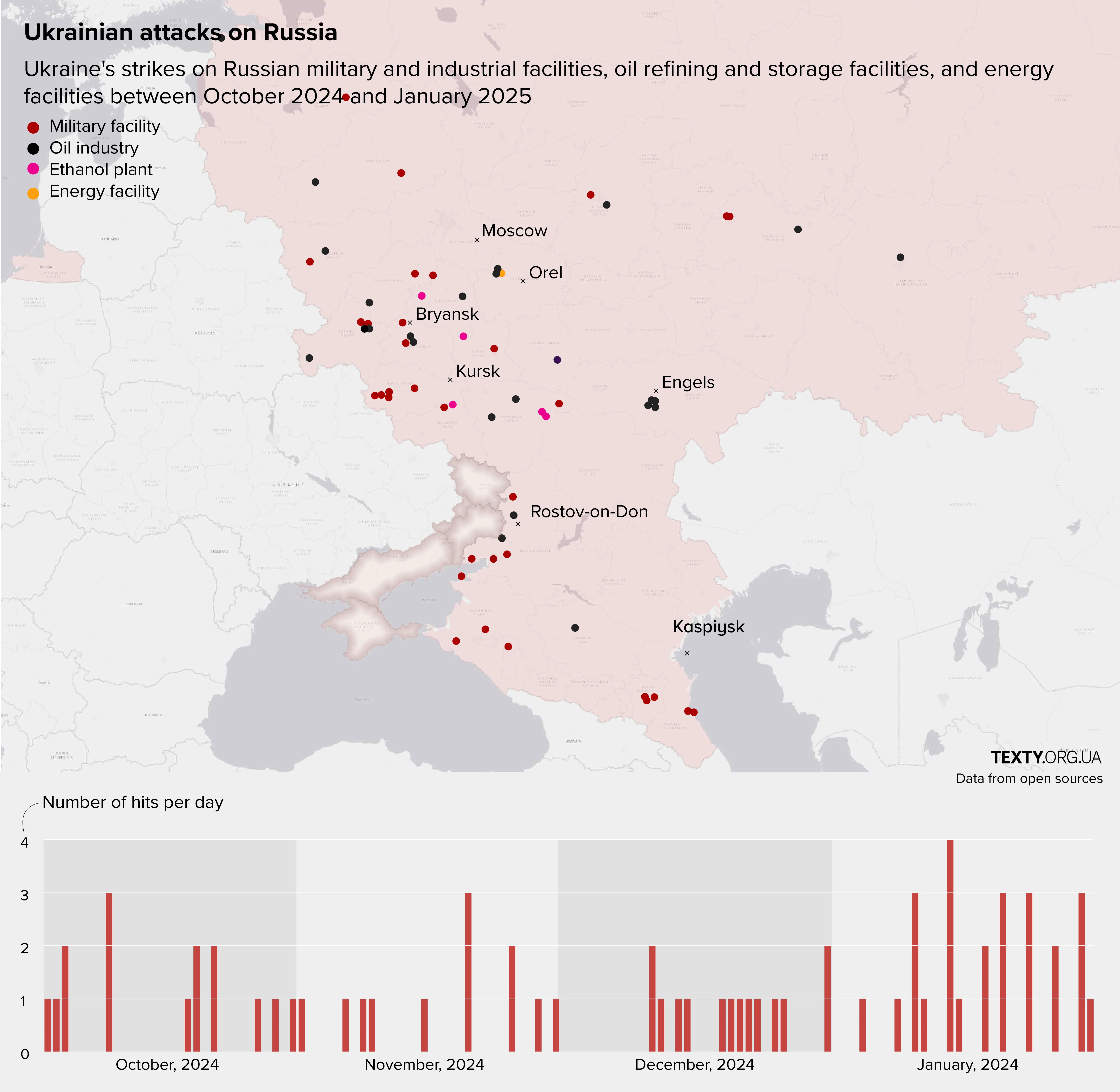How Ukraine destroys Russian military facilities and industry
Over the past four months, the nature of Ukrainian strikes on Russian territory has changed significantly. We have collected data to show which targets the Ukrainian Defense Forces prioritized between October 2024 and January 2025. See the infographic on previous strikes here.

New target — Russian distilleries
In October, Ukrainian troops began targeting Russian distilleries. Within a month, the Defense Forces hit five such plants in the Belgorod, Voronezh, Tula, and Tambov regions.
Yes, it's true that in 2023-2024, Russians broke all records for drinking a strong alcohol-an average of eight liters of pure alcohol per person. But alcohol is also produced for war. Therefore, distilleries are a legitimate military target.
In particular, the Biokhim plant in the Tambov region, which was attacked in late October 2024, supplies alcohol to the Russian defense and aerospace complexes and the navy and nuclear industry.
The Russians use alcohol to produce aviation fuel and to protect aircraft skins from icing. Ethyl alcohol is processed into the compound ethylene glycol dinitrate, one of the components of explosives. That is, the occupiers use alcohol to make various types of ammunition.
The first attack on a port in Dagestan
On November 6, 2024, drones flew to Dagestan (about 1500 km from the Ukrainian border) for the first time. According to the GUR, during this attack, the drones most likely damaged the Tatarstan and Dagestan missile ships.
On the last day of November, drones attacked the port in Caspian for the second time. Then, the Russians panicked and shut down the airport in neighboring Makhachkala.
Iran supplies weapons to Russia through this very port.
Support TEXTY.org.ua
TEXTY.ORG.UA is an independent media without intrusive ads and puff pieces. We need your support to continue our work.
Russian military facilities
One of the Ukrainian Defense Forces' most critical targets from October 2024 to January 2025 was military facilities. In previous months, the JFO's efforts were more scattered: in addition to purely military targets, they attacked Russian infrastructure, radar equipment, and energy.
However, in the four months since the beginning of October, the Ukrainians have only attacked Russian energy once: On January 23, 2025, after a drone attack, the occupiers spent a long time extinguishing a large fire at the Novo-Ryazanskaya CHP plant. By September 2024, many regional power plants and smaller enemy substations had been damaged.
Texty.org.ua counted sixty-six successful attacks on Russian targets from the beginning of October 2024 to the end of January 2025. Half of them were attacks on military targets.
Ukraine's defense forces hit Russian airfields, drone assembly bases, and military factories. They destroyed places where Russians trained their soldiers and foreign mercenaries. Command posts and protected bunkers, as well as large ammunition arsenals, were targeted.
The Ukrainian Armed Forces attacked Russian military facilities on the night of January 14. They attacked the Bryansk Chemical Plant in the town of Seltsy, where Russians produced shells and components for X-59 cruise missiles. The plant was exploding for several hours. In addition, Tor and Buk anti-aircraft systems were damaged, which were supposed to shoot down Ukrainian drones but did not.
On the same day, several other strategic facilities of the Russian military-industrial complex were on fire: the Kristall plant in Engels, the Kazanorgsintez plant in Tatarstan, and the Saratov refinery.
Destruction of the Russian oil industry
In October 2024 and January 2025, Ukrainian attacks on the Russian oil industry intensified. Slightly less than half of the attacks are on such facilities. The goal remains the same: to do everything possible to ensure that the Russians do not have money for the war.
In January 2025, the Armed Forces of Ukraine began attacking not only refineries and oil depots but also large oil pumping hubs.
In particular, on January 29, 2025, the SBU and the SSO forces attacked the Andreapol station in the Tver region with drones. This is an essential link in the Baltic Pipeline System 2. Through it, Russians pump oil to the port of Ust-Luga. And this port is a key point of oil export for them after the imposition of sanctions. The Russian shadow fleet is also loaded with oil here.
Strikes on Russian oil pumping hubs are a new, more effective tactic compared to damaging refineries and oil depots. In this way, Ukraine cuts off the routes through which oil flows to refineries and tankers.
However, although oil refining in the Russian Federation fell to 267 million tons last year (the lowest in 12 years), it is too early to talk about the destruction of Russia's leading industry.
According to the General Staff, Ukrainian troops are systematically hitting facilities that supply the occupiers with equipment, ammunition, and fuel. And this work will continue until the Russians stop fighting against Ukraine.

